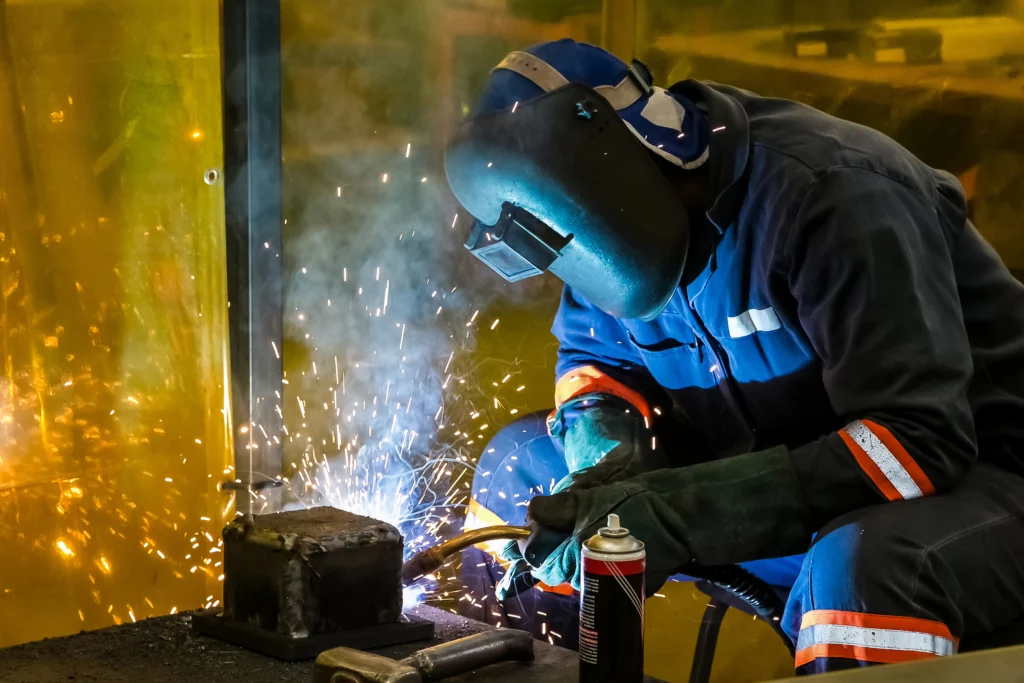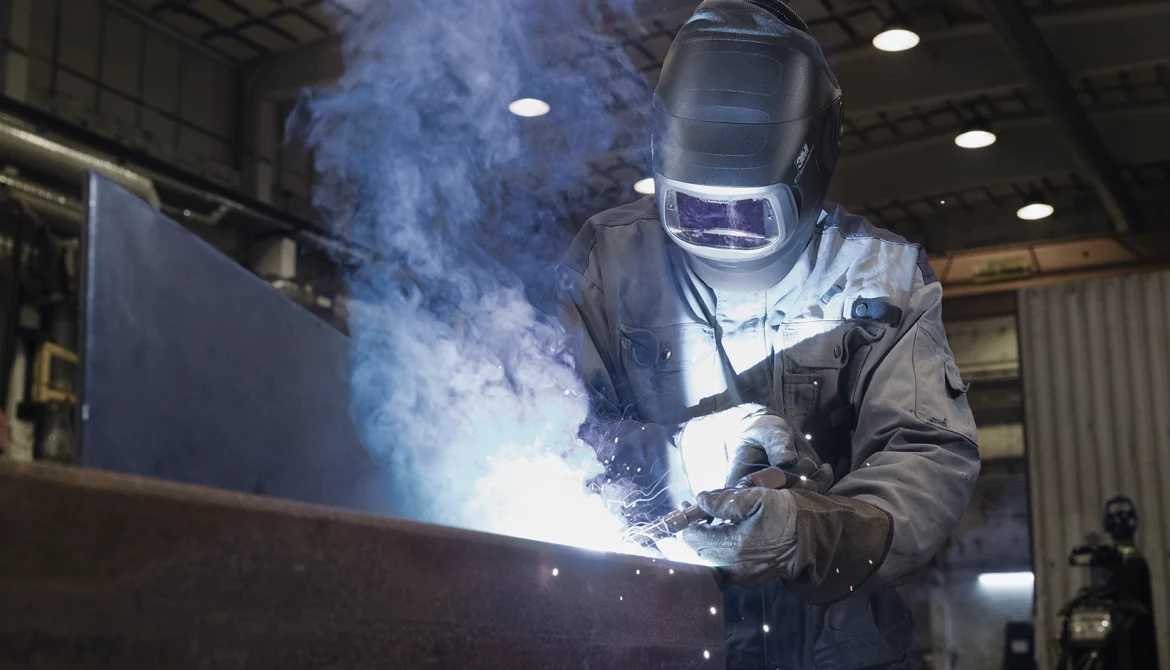Choosing the right welding helmet is crucial for safety, comfort, and efficiency. With two main options—auto-darkening and passive helmets—it can be tough to decide which one suits your needs. This guide will clearly compare both types, highlighting factors like cost, convenience, and durability, so you can make an informed choice.
We’ll share expert insights on the benefits of each helmet type and help you find the best fit for your welding tasks. Plus, we’ll guide you on maintaining your helmet for longevity and introduce other essential PPE to complete your protection.
By the end of this article, you’ll have everything you need to select the perfect welding helmet and ensure your safety on the job.
Understanding the Basics: Auto-Darkening and Passive Helmets
A welding helmet serves as a critical piece of personal protective equipment (PPE) for welders, providing effective protection for your eyes and face against UV and IR radiation. The two main types, auto-darkening helmets and passive helmets, differ in technology, functionality, and usability. Knowing the distinctions can significantly impact your welding experience.
- Auto-darkening helmets use sensors to adjust the lens’ darkness based on the intensity of the welding arc, complying with European PPE safety standards (EN 175 and EN 379). They are versatile and convenient. Learn more about EN Standards from this guide in Wikipedia.
- Passive helmets have a fixed-shade lens, requiring the welder to lift and lower the helmet manually when starting or stopping a weld, offering simplicity and reliability for tasks like stick welding.
Key Differences Between Auto-Darkening and Passive Helmets
| Feature | Auto-Darkening Helmets | Passive Helmets |
| Lens Technology | Automatic shade adjustment based on arc intensity (ideal for TIG and MIG welding) | Fixed shade, typically shade 10 or higher (best for stick welding) |
| Convenience | No need to lift the helmet between welds | Requires manual adjustment |
| Cost | Generally more expensive | More affordable |
| Durability | Components are designed for adjustability and easy maintenance when needed | Simple and robust design |
| Suitability | Ideal for frequent or precision welding tasks | Best for occasional or basic welding |
Advantages of Auto-Darkening Helmets
Auto-darkening helmets are highly popular among professional welders due to their advanced features and convenience. Here are some of their key benefits:
- Increased Efficiency: You can maintain focus without repeatedly lifting and lowering the helmet.
- Improved Safety: Sensors automatically adjust the lens’ shade to ensure your eyes are protected from varying light intensities safely and effectively.
- Versatility: Adjustable settings allow you to adapt to various welding techniques and environments.
Benefits of Passive Helmets
While passive helmets may lack modern technology, they are far from obsolete. Many welders still prefer them for specific scenarios:
- Reliability: Their simple design promotes durability and requires minimal upkeep, offering long-term reliability.
- Affordability: Cost-effective, making them ideal for beginners or occasional use.
- No Battery Dependency: They function without the need for batteries or electronics, ensuring uninterrupted use.
Choosing the Right Helmet for Your Needs

Your choice depends on several factors, including:
- Frequency of Use: If you weld daily, an auto-darkening helmet’s convenience justifies its higher cost. For less frequent tasks, a passive helmet provides a practical and reliable option.
- Type of Welding: Auto-darkening helmets enhance precision and adapt easily to variable light conditions, making them ideal for tasks like TIG or MIG welding. Learn more about Gas, Metal, and Arc Welding from this guide.
- Budget: Passive helmets are a great budget-friendly option without compromising safety.
Explore our full range of welding helmets, including both auto-darkening and passive models for diverse welding needs. to find the perfect match for your needs.
Complementary PPE for Welding
Welding involves more than just protecting your eyes. Equip yourself with the following:
- Welding Goggles: Ideal for cutting and grinding tasks. Learn more in our guide to welding glasses.
- Welding Gloves: Protect your hands from heat and sparks. Check out welding gloves.
- Fire-retardant Jackets: Work confidently near intense heat with a fire-retardant jacket.
- Fire-retardant Trousers: Combine with jackets for full-body protection. Explore work trousers.
Maintenance Tips for Longevity
Regular maintenance of your helmet is essential to ensure it remains compliant with European PPE standards, such as EN 175 for face and eye protection.
To ensure the longevity of your welding helmet:
- Clean the Lens Regularly: Use a soft cloth and appropriate cleaning solution to remove debris.
- Inspect for Damage: Inspect straps, sensors, and lenses periodically to ensure consistent performance and safety.
- Replace Batteries (Auto-Darkening Models): Having spare batteries ready ensures seamless operation of your auto-darkening helmet.
For more maintenance advice, refer to our sibling article: Understanding Lens Shades and Their Importance in Welding Helmets.
Conclusion
We hope this guide has helped clarify the key factors to consider when choosing the right welding helmet, from lens technology to comfort and safety. Whether you’re a professional welder or just starting, we’re here to support your needs and ensure you find the perfect helmet for your tasks.
Explore our detailed guides and product offerings to find the right fit for your needs. Start with our comprehensive welding helmet selection. Don’t forget to check out complementary PPE to ensure complete protection.
Further Reading:
Have any questions or need assistance in finding the right helmet? Feel free to reach out—we’re always here to help and ensure your safety and confidence with every purchase.
– The Droppe Team
Frequently Asked Questions
If the lens is scratched, cracked, or not darkening properly, it’s time for a replacement to maintain safety and visibility.
Yes, they are versatile and work well for MIG, TIG, and stick welding, adapting to different light conditions.
While passive helmets are reliable, auto-darkening helmets offer better precision and ease for tasks requiring frequent adjustments.
Battery life typically lasts around 1-3 years, depending on usage. It’s always good to keep spares on hand.
Yes, it’s recommended to wear protective gloves, jackets, and other PPE to ensure full-body safety during welding.

















